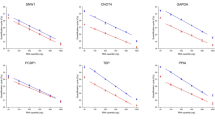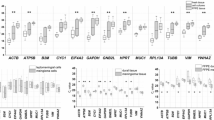Abstract
Aim
We sought to identify stably expressed genes in tumors of gingivo-buccal region and tongue from untreated as well as treated patients.
Background
The study was undertaken in view of the ambiguity with regards to the choice of reference genes for normalization of gene expression data from gingivo-buccal region and tongue. This aspect was also examined in tumors from treated patients since it could provide clues for such analyses in the assessment of treatment modalities in the future.
Methods
Expression of ten candidate housekeeping genes, identified in array-based studies, was tested using TaqMan based semi-quantitative real-time PCR. Thirty-five buccal mucosa derived (18 from treated patients) and 15 tongue tumors (8 from treated patients) were studied. Most stable genes were identified based on the consensus between the results of the three methods, Comparative δCt, BestKeeper and NormFinder, used for data analysis.
Results
CHMP2A and VPS29 were identified as the most stably expressed genes suitable for normalization of data from buccal-mucosa tumors, whereas RPS13 and PSMB2 were indicated for similar specimens from treated patients. The same criteria identified stable expression of PSMB2 and PUM1 in tumors from tongue and OAZ1 and RPS13 for the post-treatment tongue tumors.
Conclusion
We have identified stably expressed genes in common oral cancers which can be used for normalization of the gene expression data. Results also established differences in tumors arising at different sites of the oral cavity and highlighted further changes following exposure to therapy.

Similar content being viewed by others
References
Thellin O, Zorzi W, Lakaye B, De Borman B, Coumans B, Hennen G et al (1999) Housekeeping genes as internal standards: use and limits. J Biotechnol 75(2–3):291–295
Catalan V, Gomez-Ambrosi J, Rotellar F, Silva C, Rodriguez A, Salvador J et al (2007) Validation of endogenous control genes in human adipose tissue: relevance to obesity and obesity-associated type 2 diabetes mellitus. Horm Metab Res 39(7):495–500
Dheda K, Huggett JF, Chang JS, Kim LU, Bustin SA, Johnson MA et al (2005) The implications of using an inappropriate reference gene for real-time reverse transcription PCR data normalization. Anal Biochem 344(1):141–143
Kolkova Z, Arakelyan A, Casslen B, Hansson S, Kriegova E (2013) Normalizing to GADPH jeopardises correct quantification of gene expression in ovarian tumours—IPO8 and RPL4 are reliable reference genes. J Ovarian Res 6(1):60
Eisenberg E, Levanon EY (2013) Human housekeeping genes, revisited. Trends Genet TIG 29(10):569–574
Zhu J, He F, Hu S, Yu J (2008) On the nature of human housekeeping genes. Trends Genet TIG 24(10):481–484
Chang CW, Cheng WC, Chen CR, Shu WY, Tsai ML, Huang CL et al (2011) Identification of human housekeeping genes and tissue-selective genes by microarray meta-analysis. PLoS One 6(7):e22859
de Jonge HJ, Fehrmann RS, de Bont ES, Hofstra RM, Gerbens F, Kamps WA et al (2007) Evidence based selection of housekeeping genes. PLoS One 2(9):e898
Chen M, Xiao J, Zhang Z, Liu J, Wu J, Yu J (2013) Identification of human HK genes and gene expression regulation study in cancer from transcriptomics data analysis. PLoS One 8(1):e54082
Rubie C, Kempf K, Hans J, Su T, Tilton B, Georg T et al (2005) Housekeeping gene variability in normal and cancerous colorectal, pancreatic, esophageal, gastric and hepatic tissues. Mol Cell Probes 19(2):101–109
Lee PD, Sladek R, Greenwood CM, Hudson TJ (2002) Control genes and variability: absence of ubiquitous reference transcripts in diverse mammalian expression studies. Genome Res 12(2):292–297
Pfaffl MW, Tichopad A, Prgomet C, Neuvians TP (2004) Determination of stable housekeeping genes, differentially regulated target genes and sample integrity: Bestkeeper–Excel-based tool using pair-wise correlations. Biotechnol Lett 26(6):509–515
Lyng MB, Laenkholm AV, Pallisgaard N, Ditzel HJ (2008) Identification of genes for normalization of real-time RT-PCR data in breast carcinomas. BMC Cancer 8:20
Vandesompele J, De Preter K, Pattyn F, Poppe B, Van Roy N, De Paepe A et al (2002) Accurate normalization of real-time quantitative RT-PCR data by geometric averaging of multiple internal control genes. Genome Biol 3(7):research0034.1
Bennani-Baiti B, Toegel S, Viernstein H, Urban E, Noe CR, Bennani-Baiti IM (2015) Inflammation modulates RLIP76/RALBP1 electrophile-glutathione conjugate transporter and housekeeping genes in human blood-brain barrier endothelial cells. PLoS One 10(9):e0139101
Song W, Zhang WH, Zhang H, Li Y, Zhang Y, Yin W et al (2016) Validation of housekeeping genes for the normalization of RT-qPCR expression studies in oral squamous cell carcinoma cell line treated by 5 kinds of chemotherapy drugs. Cell Mol Biol 62(13):29–34
Elango JK, Gangadharan P, Sumithra S, Kuriakose MA (2006) Trends of head and neck cancers in urban and rural India. Asian Pac J Cancer Prev APJCP 7(1):108–112
Alam H, Sehgal L, Kundu ST, Dalal SN, Vaidya MM (2011) Novel function of keratins 5 and 14 in proliferation and differentiation of stratified epithelial cells. Mol Biol Cell 22(21):4068–4078
Bhosale PG, Cristea S, Ambatipudi S, Desai RS, Kumar R, Patil A et al (2017) Chromosomal alterations and gene expression changes associated with the progression of leukoplakia to advanced gingivobuccal cancer. Transl Oncol 10(3):396–409
Rao RS, Patil S, Ghosh S, Kumari K (2015) Current aspects and future strategies in oral cancer research: a review. J Med Radiol Pathol Surg 1(3):8–13
Rentoft M, Hultin S, Coates PJ, Laurell G, Nylander K (2010) Tubulin alpha-6 chain is a stably expressed reference gene in archival samples of normal oral tissue and oral squamous cell carcinoma. Exp Ther Med 1(3):419–423
Lallemant B, Evrard A, Combescure C, Chapuis H, Chambon G, Raynal C et al (2009) Reference gene selection for head and neck squamous cell carcinoma gene expression studies. BMC Mol Biol 10(1):78
Gemenetzidis E, Bose A, Riaz AM, Chaplin T, Young BD, Ali M et al (2009) FOXM1 upregulation is an early event in human squamous cell carcinoma and it is enhanced by nicotine during malignant transformation. PLoS One 4(3):e4849
Lu J, Ma H, Lian S, Huang D, Lian M, Zhang Y, et al (2017) Clinical significance and prognostic value of the expression of LAMP3 in oral squamous cell carcinoma. Dis Markers 2017;2017:1218254
Egloff AM, Liu X, Davis ALG, Trevelline BK, Vuga M, Siegfried JM et al (2013) Elevated gastrin-releasing peptide receptor mRNA expression in buccal mucosa: association with head and neck squamous cell carcinoma. Head Neck 35(2):270–279
Spivack SD, Hurteau GJ, Jain R, Kumar SV, Aldous KM, Gierthy JF et al (2004) Gene-environment interaction signatures by quantitative mRNA profiling in exfoliated buccal mucosal cells. Cancer Res 64(18):6805–6813
Hirano C, Nagata M, Noman AA, Kitamura N, Ohnishi M, Ohyama T et al (2009) Tetraspanin gene expression levels as potential biomarkers for malignancy of gingival squamous cell carcinoma. Int J Cancer 124(12):2911–2916
Kurokawa A, Nagata M, Kitamura N, Noman AA, Ohnishi M, Ohyama T et al (2008) Diagnostic value of integrin α3, β4, and β5 gene expression levels for the clinical outcome of tongue squamous cell carcinoma. Cancer Interdiscip Int J Am Cancer Soc 112(6):1272–1281
Clatot F, Gouérant S, Mareschal S, Cornic M, Berghian A, Choussy O et al (2014) The gene expression profile of inflammatory, hypoxic and metabolic genes predicts the metastatic spread of human head and neck squamous cell carcinoma. Oral Oncol 50(3):200–207
Sun Y, Li Y, Luo D, Liao DJ (2012) Pseudogenes as weaknesses of ACTB (Actb) and GAPDH (Gapdh) used as reference genes in reverse transcription and polymerase chain reactions. PLoS One 7(8):e41659
Sikand K, Singh J, Ebron JS, Shukla GC (2012) Housekeeping gene selection advisory: glyceraldehyde-3-phosphate dehydrogenase (GAPDH) and β-actin are targets of miR-644a. PLoS One 7(10):e47510
Chen D, Pan X, Xiao P, Farwell MA, Zhang B (2011) Evaluation and identification of reliable reference genes for pharmacogenomics, toxicogenomics, and small RNA expression analysis. J Cell Physiol 226(10):2469–2477
Haller F, Kulle B, Schwager S, Gunawan B, von Heydebreck A, Sültmann H et al (2004) Equivalence test in quantitative reverse transcription polymerase chain reaction: confirmation of reference genes suitable for normalization. Anal Biochem 335(1):1–9
Schmittgen TD, Zakrajsek BA (2000) Effect of experimental treatment on housekeeping gene expression: validation by real-time, quantitative RT-PCR. J Biochem Biophys Methods 46(1–2):69–81
Silver N, Best S, Jiang J, Thein SL (2006) Selection of housekeeping genes for gene expression studies in human reticulocytes using real-time PCR. BMC Mol Biol 7(1):33
Andersen CL, Jensen JL, Ørntoft TF (2004) Normalization of real-time quantitative reverse transcription-PCR data: a model-based variance estimation approach to identify genes suited for normalization, applied to bladder and colon cancer data sets. Cancer Res 64(15):5245–5250
Tilli TM, Castro Cda S, Tuszynski JA, Carels N (2016) A strategy to identify housekeeping genes suitable for analysis in breast cancer diseases. BMC Genomics 17(1):639
Hildyard JCW, Finch AM, Wells DJ (2019) Identification of qPCR reference genes suitable for normalizing gene expression in the mdx mouse model of Duchenne muscular dystrophy. PLoS One 14(1):e0211384
Mukhopadhyay R, Ray PS, Arif A, Brady AK, Kinter M, Fox PL (2008) DAPK-ZIPK-L13a axis constitutes a negative-feedback module regulating inflammatory gene expression. Mol Cell 32(3):371–382
Folgueira K, Azevedo MA, Brentani H, Carraro DM, De Filho MCB, Katayama MLH et al (2009) Gene expression profile of residual breast cancer after doxorubicin and cyclophosphamide neoadjuvant chemotherapy. Oncol Rep 22(4):805–813
Acknowledgements
This work was supported by an intramural grant from the Tata Memorial Centre, Parel, Mumbai 400012 India. The assistance by the ICMR National Tumor Tissue Repository at TMH is gratefully acknowledged. The authors would especially like to thank Mrs. Manisha Kulkarni and Mr. Anand Deshpande from the ICMR National Tumor Tissue Repository at TMH for their assistance in procurement of the specimens. The authors would also like to thank Mr. Jaykumar Kambli for his assistance in the study, Dr Manoj Mahimkar and Dr Milind Vaidya of ACTREC, Tata Memorial Centre, for their valuable suggestions and support during the study as well as in manuscript preparation.
Funding
This study was funded by an Intramural grant from the Tata Memorial Centre, Mumbai 400012 India.
Author information
Authors and Affiliations
Corresponding author
Ethics declarations
Conflict of interest
Dr. Narendra Joshi declares that he has no conflict of interest. Mr. Sanit Mhatre declares that he has no conflict of interest. Mr. Aniket Parab declares that he has no conflict of interest. Mrs. Sadhana Kannan declares that she has no conflict of interest. Mrs. Sujata Hake declares that she has no conflict of interest. Dr. Prathamesh Pai declares that he has no conflict of interest. Dr. Shubhada Kane declares that she has no conflict of interest.
Research involving human participants and/or animals
All the procedures involving human participants were performed in accordance with the ethical standards of the institutional and national research committees (guidelines) and with the 1964 Helsinki Declaration and its later amendments or comparable ethical standards. This article does not contain any studies with animals performed by any of the authors.
Informed consent
Informed consent was obtained from all individual participants included in the study.
Additional information
Publisher's Note
Springer Nature remains neutral with regard to jurisdictional claims in published maps and institutional affiliations.
Electronic supplementary material
Below is the link to the electronic supplementary material.
Rights and permissions
About this article
Cite this article
Parab, A., Mhatre, S., Hake, S. et al. Identification of stably expressed genes for normalization of gene expression data in oral tumors: a preliminary analysis. Oral Cancer 3, 49–58 (2019). https://doi.org/10.1007/s41548-019-00020-y
Received:
Accepted:
Published:
Issue Date:
DOI: https://doi.org/10.1007/s41548-019-00020-y




